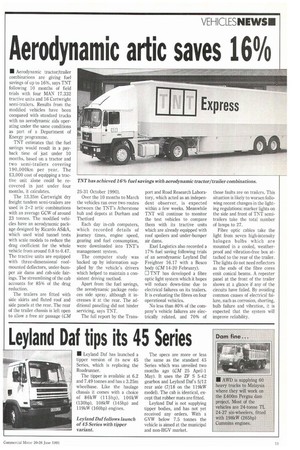Aerodynamic artic saves 16°/0
Page 13

If you've noticed an error in this article please click here to report it so we can fix it.
NI Aerodynamic tractor/trailer combinations are giving fuel savings of up to 16%, says TNT following 10 months of field trials with four MAN 17.332 tractive units and 16 Cartwright semi-trailers. Results from the modified vehicles have been compared with standard trucks with no aerodynamic aids operating under the same conditions as part of a Department of Energy programme.
TNT estimates that the fuel savings would result in a payback time of just under 10 months, based on a tractor and two semi-trailers covering 190,000km per year. The £3,000 cost of equipping a tractive unit alone could be recovered in just under four months, it calculates.
The 13.35m Cartwright dry freight tandem semi-trailers are used in 2+2 artic combinations with an average GCW of around 23 tonnes. The modified vehicles have an aerodynamic package designed by Ricardo AS&A, which used wind tunnel tests with scale models to reduce the drag coefficient for the whole vehicle from around 0.8 to 0.47. The tractive units are equipped with three-dimensional roofmounted deflectors, under-bumper air dams and cab-side fairings. The streamlining of the cab accounts for 85% of the drag reduction.
The trailers are fitted with side skirts and fluted roof and side panels at the rear. The rear of the trailer chassis is left open to allow a free air passage (CM
25-31 October 1990).
Over the 10 months to March the vehicles ran over two routes between the TNT's Atherstone hub and depots at Durham and Thetford Each day in-cab computers, which recorded details of journey times, engine speed, gearing and fuel consumption, were downloaded into TNT's management system.
The computer study was backed up by information supplied by the vehicle's drivers which helped to maintain a consistent driving method.
Apart from the fuel savings, the aerodynamic package reduces side spray, although it increases it at the rear. The additional panelling did not hinder servicing, says TNT.
The full report by the Trans port and Road Research Laboratory, which acted as an independent observer, is expected within a few weeks. Meanwhile TNT will continue to monitor the test vehicles to compare them with its tractive units which are already equipped with roof spoilers and under-bumper air dams.
Exel Logistics also recorded a 17% fuel saving following trials of an aerodynamic Leyland Daf Freighter 16.17 with a Besco body (CM 14-20 February).
1:1 TNT has developed a fibre optic light system which it hopes will reduce down-time due to electrical failures on its trailers. It is evaluating the fibres on four operational vehicles.
No less than 80% of the company's vehicle failures are electrically related, and 70% of those faults are on trailers. This situation is likely to worsen following recent changes in the lighting regulations: marker lights on the side and front of TNT semitrailers take the total number of lamps to 27.
Fibre optic cables take the light from seven high-intensity halogen bulbs which are mounted in a cooled, weatherproof and vibration-free box attached to the rear of the trailer. The lights do not need reflectors as the ends of the fibre cores emit conical beams. A repeater panel at the front of the trailer shows at a glance if any of the circuits have failed. By avoiding common causes of electrical failure, such as corrosion, shorting, bulb failure and vibration, it is expected that the system will improve reliability.
























































































